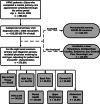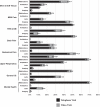The association between video or telephone telemedicine visit type and orders in primary care
- PMID: 36403030
- PMCID: PMC9675192
- DOI: 10.1186/s12911-022-02040-z
The association between video or telephone telemedicine visit type and orders in primary care
Abstract
Introduction: Telemedicine is increasingly relied upon for care delivery in primary care, but the impact of visit type on clinical ordering behavior is uncertain.
Methods: Within Kaiser Permanente Northern California, we identified patients who self-scheduled and completed telemedicine encounters with their personal primary care provider or another available primary care provider in the same medical group, between April 1st, 2020, and October 31st, 2020, while physical distancing restrictions for COVID-19 were in place. We collected patient sociodemographic and clinical characteristics, measures of technology access, and categorized the most common primary encounter diagnoses. We measured proportions of patient-scheduled video versus telephone visits for each of eight diagnosis groups (Skin & Soft Tissue, Musculoskeletal Pain, Back Pain, General Gastrointestinal, Hypertension & Diabetes, Mental Health, Upper Respiratory, and Abdominal Pain), and compared physician orders for medications, antibiotics, lab and imaging studies by visit type within each diagnosis group.
Results: There were 273,301 included encounters, with 86,676 (41.5%) video visits and 122,051 (58.5%) telephone visits. Of the diagnosis groups, Skin & Soft Tissue conditions had the highest proportion of video visits (59.7%), while Mental Health conditions had the highest proportion of telephone visits (71.1%). After adjusting for covariates, the overall rates of medication orders (46.6% vs. 44.5%), imaging orders (17.3% vs. 14.9%), lab orders (19.5% vs. 17.2%), and antibiotic orders (7.5% vs. 5.2%) were higher during video visits as compared to telephone visits (p < 0.05). The largest difference within diagnosis groups was for Skin & Soft Tissue conditions, where the rate of medication orders was 9.1% higher than during video visits than telephone visits (45.5% vs. 36.5%, p < 0.05).
Conclusions: We observed statistically significant differences in clinician orders by visit type during telemedicine encounters for common primary care conditions. Our findings suggest that, for certain conditions, visual information conveyed during video visits may promote clinical work-up and treatment.
Keywords: Clinical orders; Primary care; Telemedicine; Visit type.
© 2022. The Author(s).
Conflict of interest statement
The authors declare they have no competing interests.
Figures



Similar articles
-
Telemedicine Versus In-Person Primary Care: Treatment and Follow-up Visits.Ann Intern Med. 2023 Oct;176(10):1349-1357. doi: 10.7326/M23-1335. Ann Intern Med. 2023. PMID: 37844311 Free PMC article.
-
Patient Characteristics Associated With Choosing a Telemedicine Visit vs Office Visit With the Same Primary Care Clinicians.JAMA Netw Open. 2020 Jun 1;3(6):e205873. doi: 10.1001/jamanetworkopen.2020.5873. JAMA Netw Open. 2020. PMID: 32585018 Free PMC article.
-
Health Care Utilization With Telemedicine and In-Person Visits in Pediatric Primary Care.JAMA Health Forum. 2024 Nov 1;5(11):e244156. doi: 10.1001/jamahealthforum.2024.4156. JAMA Health Forum. 2024. PMID: 39576615 Free PMC article.
-
Cervical Spine Evaluation by Telephone and Video Visit.Cureus. 2021 Nov 19;13(11):e19741. doi: 10.7759/cureus.19741. eCollection 2021 Nov. Cureus. 2021. PMID: 34938620 Free PMC article. Review.
-
Future of Telemedicine in Radiation Oncology.Semin Radiat Oncol. 2024 Oct;34(4):463-467. doi: 10.1016/j.semradonc.2024.07.010. Semin Radiat Oncol. 2024. PMID: 39271281 Review.
Cited by
-
Telemedicine Versus In-Person Primary Care: Treatment and Follow-up Visits.Ann Intern Med. 2023 Oct;176(10):1349-1357. doi: 10.7326/M23-1335. Ann Intern Med. 2023. PMID: 37844311 Free PMC article.
-
Downstream Emergency Department and Hospital Utilization Comparably Low Following In-Person Versus Telemedicine Primary Care for High-Risk Conditions.J Gen Intern Med. 2024 Oct;39(13):2446-2453. doi: 10.1007/s11606-024-08885-6. Epub 2024 Jul 12. J Gen Intern Med. 2024. PMID: 38997530
-
Patient-reported Primary Care Video and Telephone Telemedicine Preference Shifts During the COVID-19 Pandemic.Med Care. 2023 Nov 1;61(11):772-778. doi: 10.1097/MLR.0000000000001916. Epub 2023 Sep 19. Med Care. 2023. PMID: 37733433 Free PMC article.
-
Telehealth Challenges, Opportunities, and Policy Recommendations for Rural Older Adults Living with HIV in the United States.J Aging Soc Policy. 2024 Nov 4:1-19. doi: 10.1080/08959420.2024.2422658. Online ahead of print. J Aging Soc Policy. 2024. PMID: 39494858
-
Physician experiences with teleconsultations amidst conflict in Sudan.Sci Rep. 2023 Dec 20;13(1):22688. doi: 10.1038/s41598-023-49967-5. Sci Rep. 2023. PMID: 38114741 Free PMC article.
References
-
- WHO. Telemedicine: Opportunities and developments in member states: Report on the second global survey on ehealth. WHO Press 12/06/2020 2010.
-
- Moth G, Huibers L, Christensen MB, Vedsted P. Drug prescription by telephone consultation in danish out-of-hours primary care: a population-based study of frequency and associations with clinical severity and diagnosis. BMC Fam Pract. 2014;15(1):142. doi: 10.1186/1471-2296-15-142.Accessed2020-12-14T23:38:34. - DOI - PMC - PubMed
Publication types
MeSH terms
Grants and funding
LinkOut - more resources
Full Text Sources
Medical
Miscellaneous

